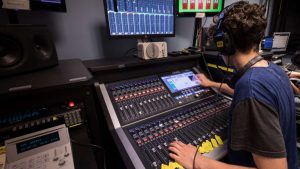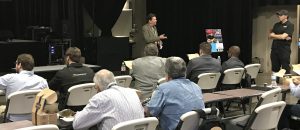Tech Focus: Broadcast-Audio Education, Part 1 — Limited Opportunities and Interest Raise Industry Concern
The worry is how the need for engineers will be met
Story Highlights
Anyone wishing to embark on a career in broadcast audio has a few choices when it comes to education and training, with the emphasis on the word few. The topic is often rolled into larger courses at colleges and universities, if it’s addressed at all, and then only at those schools — mostly state institutions — that have sizable communications programs. For-profit technical academies, even those largely predicated on audio, have largely avoided broadcast sound as a standalone subject, focusing instead on music production and, more recently, on live sound. Because state and for-profit universities continue to focus on development of talent for broadcast, the closest that many students get to the audio side is learning how to clip on a lavalier mic.
On the other hand, training elements in broadcast audio abound through the efforts of manufacturers whose equipment forms the infrastructure of the industry. However, those elements are, understandably, part of those companies’ sales and marketing strategies and thus focused largely on their own products.
Lack of Infrastructure
“The smaller schools we work with don’t touch it,” says Chris Davie, a principal in Sonority Group, an educational-marketing consultancy, and the former head of operations for SAE USA, the U.S. operation of the internationally located School of Audio Education. “The state schools that already have a well-developed communications department and do film and television, like MTSU [Middle Tennessee State University, which also operates its own remote-broadcast unit], will teach the technology side of broadcasting, including audio. But, if the infrastructure isn’t already there, it’s too much of a stretch for most schools. It’s not even on SAE’s radar anymore.”

Full Sail University emphasizes broadcast audio in its curriculum and has a close relationship with ESPN.
Some for-profit schools continue to place purposeful emphasis on broadcast audio as a subject. Full Sail University has maintained a close relationship with ESPN for years through the sports broadcaster’s parent company Disney, whose theme parks have been a regular destination for Full Sail graduates in various entertainment-technology verticals. The Conservatory of Recording Arts & Sciences (CRAS), near Phoenix, has also made significant investments in broadcast sound, including its own 42-ft. expando remote unit, which has shared connections to NFL, MLB, and NASCAR sports events with both Fox Sports and NBC Sports.
‘Television Is Meaningless to Them’
Among the reasons that higher-education institutions of all types have not pursued broadcast-audio education more intensively are that students of typical college age have less and less connection to broadcast television in general and that, at a time of declining enrollment numbers, schools are emphasizing courses that hold more allure for that key demographic.
“Students want to learn to make beats on a laptop, not run cables on the sidelines of an NFL game,” Davie explains. “Television is meaningless to them.”
Robert Brock, director, education, CRAS, is heartened to see broadcasters take on his graduates as interns, with the goal of ultimately making them employees. But that model is up against what he says is an even more deeply embedded tradition of taking students at the end of the traditional school term in June and letting internships lapse at the end of the summer.
“They get their credits and go back to school instead of moving into the industry. That’s not our idea of how it should work,” he says, referring to CRAS’s 11-month rolling admissions and graduation cycle. He contends that this unfairly limits internship access to students who complete their course of study at other times of the year, a model used by other for-profit technical schools as well. “We view internships as a kind of long-term interview process, not just a summer proposition. Also, a lot of what we teach is about mobile remote production, and few broadcasters are willing to invest in taking interns out on the road.”

The Conservatory of Recording Arts & Sciences, in conjunction with SVG, offered video-production professionals an instructional workshop on its professional-audio–education programs and the availability of interns and graduates.
There are isolated inducements for students to pursue broadcast-audio education and training. For instance, in 2016, the AES established the Larry Estrin AESEF Scholarship Fund, named for the late broadcast-audio guru and sponsored by AES Educational Foundation (AESEF), offers a grant of $5,000 annually to graduate students who are AES members and have “demonstrated commitment to audio engineering in the broadcast industry or related field with advanced studies in RF technology or communications and broadcast production.”
According to AESEF President Don Puluse, who was dean of the music-technology division at Berklee College of Music in Boston for eight years, AES offers some broadcast-audio educational information and includes it on panels at its various conferences. However, he says, “while we had some graduates from Berklee go into broadcasting, there’s not a lot of that kind of content in the usual college-level programs.”
Another trade organization, the Society of Broadcast Engineers, offers some online training courses and certifications through its website. These, says Wayne Pecena, chair, Education Committee, SBE, are tuned largely to RF- and IT-related topics, in part because many of the potential employees it sees come from ex-military and IT backgrounds, where they might have received some training relatable to broadcasting and audio.
However, he acknowledges, the paucity of broadcast-training options in general is a concern for the SBE. “Where the next generation of broadcast engineers in general, not just audio engineers, is coming from is a big issue for us,” he says. “The industry is somewhat challenged in terms of the very limited number of opportunities there are to go to school to become a broadcast engineer.”
Furthermore, he adds, as the broadcast industry more widely implements cost-containment strategies that reduce reliance on manpower, such as at-home production techniques, demand for trained engineers could ultimately be diminished, reducing the incentive for schools to address that training and creating a cycle of lessened opportunities overall.
John Krivit, AES past president and chair of the organization’s Education Committee, says that, as a long-time faculty member at Boston’s Emerson College, which has a significant broadcasting curriculum — it taught the first course in radio in 1931 — he emphasizes the economics of professional audio as much as its technology. He does the same in a new position at Professional Audio Design, a Boston pro-audio vendor that sells to schools, among other customers.
“When I talk to educators about outcomes, I tell them they’re doing a disservice to students when they just talk about making records,” he says. “Most people entering audio classes come for music production, but, if we can find students who like sports as much as they like music, we can create a recipe to make them aware of what the possibilities are.”
